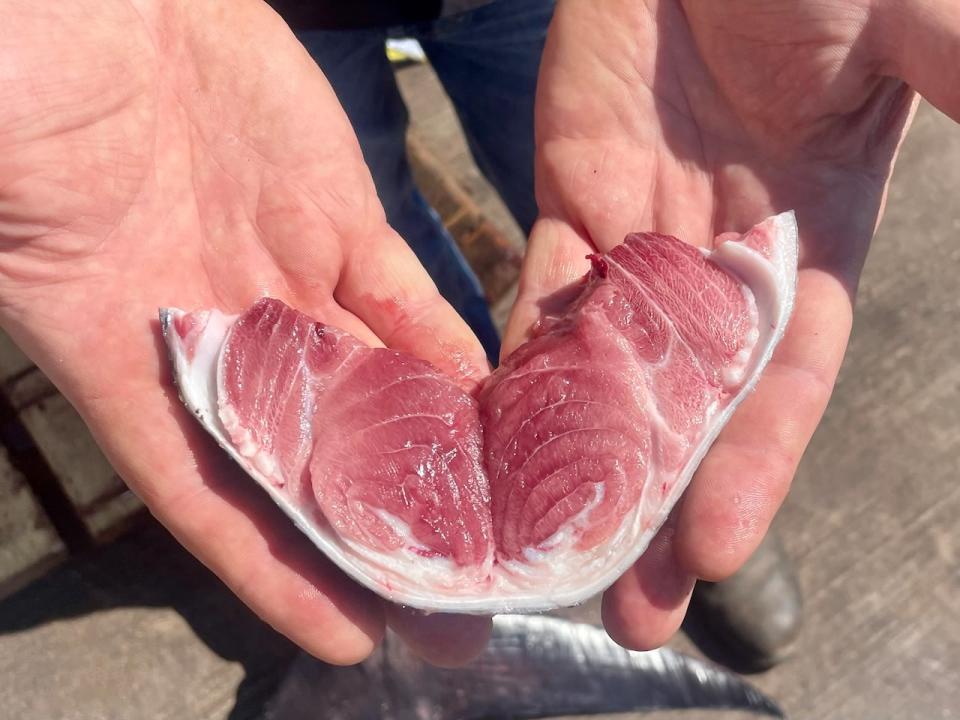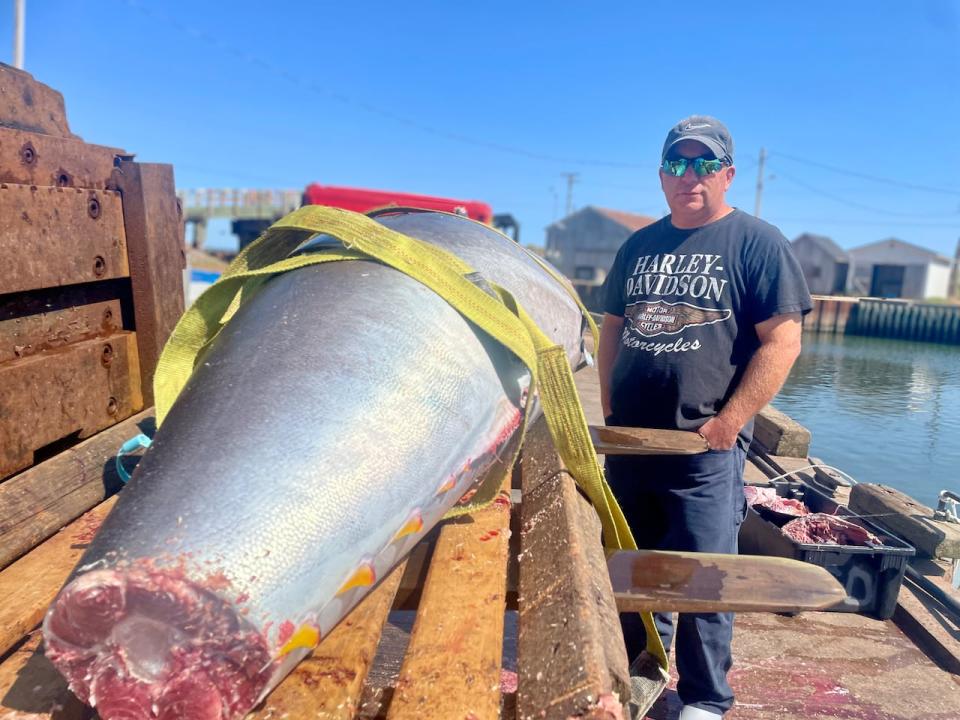


About a third of the way through Prince Edward Island’s bluefin tuna season, fishing crews are reeling in some of the fattiest tuna and highest prices they’ve seen in decades.
“We’re seeing prices range from $10 or $11 on the low side to $40, $50, $60 a pound on the high side. So these are higher prices than we’ve seen, probably since the early 90s,” said Jason Tompkins, owner of TNT Tuna in North Lake, which buys and exports about three-quarters of Canada’s bluefin tuna quota.
Tompkins says in a normal season, just “one or two” of the roughly 1,500 tuna caught off the northeast coast of P.E.I. will earn the boat more than $10,000, after being sold on high-end markets around North America, Europe and Japan.
So far this year?
“We’ve had probably 14 or 15 fish that have returned over $10,000,” he said. With each boat getting two or three tags allowing them to catch that number of fish each season, “that’s $20,000 or $30,000 for a few days’ work. So it’s really nice to see returns like that come back.”

Jason Tompkins, owner of TNT Tuna in North Lake, said fishing crews on P.E.I. are getting some of the highest prices for their catch they’ve seen in decades. (Steve Bruce/CBC)
The key to those high returns? The all-tuna-can-eat buffet in the waters off Canada’s smallest province.
Bluefin tuna feast on herring and mackerel. A couple years ago, facing depleting stocks, Fisheries and Oceans Canada banned commercial bait fishing for herring in the Gulf of St. Lawrence, and for mackerel in waters across Atlantic Canada and off Quebec.
The tuna have taken full advantage.
“For the first two months of the season, we’ve had some of the only fatty tuna in the world,” said Tompkins. “Fat is flavour, no different than beef. So the more fat, the more flavour. The more flavour, the higher the price.
“And we’ve had pretty much the high price in Japan every night for the last six weeks.”
‘The Japanese market is helping’
Japan is the other key to this season’s success.
That sushi-loving country has long been the biggest buyer of P.E.I. tuna, though the COVID-19 pandemic cut into markets for a while.
Finally, Japan’s economy and tourism industry are rebounding, along with the demand for high-quality tuna.
It’s well marbled all the way down through to the bone. This is triple-A grade top quality, and can go anywhere in the world, whether it be a six-star restaurant in Dubai, or downtown Tokyo. — Jason Tompkins
“The Japanese market is helping for sure,” Glen Doucette said Friday from the wharf in Naufrage, after catching a tuna weighing in at 450 pounds, or 204 kilograms.
“Last few years, we sold a lot more domestically, [in] Canada and the U.S. But this year, the Japanese market’s a lot better. So it’s looking a lot better.”
Add it all together, and fishers like Doucette are feeling “very hopeful” they can earn some good money this season.


‘This is really what we’re looking for — well handled, really nice shape… It’s well marbled all the way down through to the bone. This is triple-A grade top quality,’ buyer and exporter Jason Tompkins said of Doucette’s tuna. (Steve Bruce/CBC)
Doucette lives in New Brunswick most of the year, and fishes lobster in the spring. He travels to P.E.I. for tuna season — and so far, that seems to be paying off. His latest catch is about as good as it gets.
“The size, the shape, the colour, a little bit of fat in ‘er. So everything’s going for me. Hopefully she’ll pay off, this one,” he said.
Tompkins was sure it would.
“It’s well marbled all the way down through to the bone. This is triple-A grade top quality, and can go anywhere in the world, whether it be a six-star restaurant in Dubai, or downtown Tokyo,” said Tompkins. “This is exactly what we’ve been seeing.”
High prices, high expenses
Gregory Bell is hoping for a prize catch with his third and final tuna. His second was decent, though not the “top quality” some others have seen.


Tuna fisher Glen Doucette poses with Friday’s catch. ‘Everything’s going for me. Hopefully she’ll pay off, this one,’ he said of the bluefin tuna. (Steve Bruce/CBC)
“The expenses fishermen have these days — fuel and everything is going up, right? So we need good prices to pay for the expenses we have to put out,” said Bell.
Tompkins said while tuna prices and demand tend to soften slightly around back-to-school time, he expects they’ll rebound into October and November as the season wraps up.
And with no signs of the Japanese market cooling, or Canada’s commercial bait fishery returning, he said all signs point to a bright future ahead for P.E.I.’s 330 tuna fishers.
“As of right now, we don’t see anything that’s going to buck this trend.”